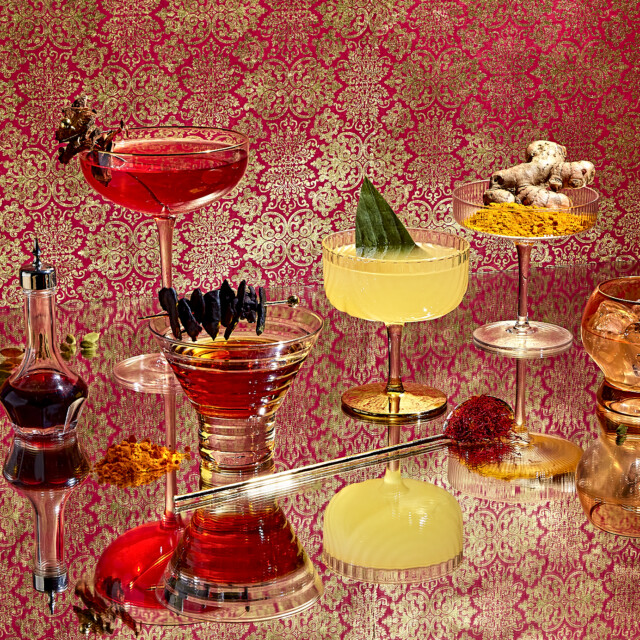At Bay Area Indian restaurant Pippal, the cocktail menu has the look and feel of a retro travel brochure. Thick and colorful, it features inviting photos of the vast country’s architectural landmarks and natural landscapes, from the well-known Taj Mahal to the backwaters of Kerala. Under each frame, dynamic spices and fruits enhance the wanderlust effect: rasam, tamarind, banana leaf. The lineup is a love letter to India’s dazzling selection of regional ingredients — something the U.S cocktail scene is finally getting a better taste of.
In the past few years, Indian fine dining has taken flight all over the country, and with it came beverage programs that color way, way outside the lines. And as upscale Indian restaurants continue to highlight more and more parts of their home nation, their bar programs also have become more specialized. Not only do these innovative drinks offer completely new flavor profiles, but by introducing fruits, plants and spices native to India, they speak of regionality and tradition both abided and subverted.
“We focused our cocktails on different, lesser known heritage properties,” says Izler Thomas, Pippal’s bar manager, of the bar’s impressive booklet. “Every cocktail represents the monument it’s named after in terms of visuals and ingredients sourced from India.” For example, a cocktail named after Kolkata’s Howrah Bridge is made with Jaan Paan liquor. While Canadian itself, the spirit contains betel leaf (paan), a plant cultivated in many Indian states including Bengal.
Betel leaf, alongside many spices from the Indian pantry — cardamom, saffron, turmeric, curry leaf and ginger, among others — are finally getting cast as the stars of cocktail menus that favor super-regional storytelling. At New York City restaurant Semma, which focuses on southern Indian cuisine, the Matka Paan Old Fashioned is fortified with paan and served with coconut ice, highlighting ingredients that are staples in the warm, humid south. At Rooh in Chicago, curry bitters punch up a brunch cocktail called Indian 75. And Los Angeles’s recently opened Baar Baar puts its own twist on flavor discovery by tying each of its seasonal cocktails to a corresponding film: Anarkali, named after a 1953 Bollywood classic, is a take on the equally classic Negroni featuring Darjeeling tea from the eastern foothills of the Himalayas, while the Slumdog Millionaire is made with raw turmeric from India’s eastern and southern regions.
The components for Baar Baar’s drinks are sourced from local Indian grocers, says chef Sujan Sarkar, who worked with mixologist Chetan Gangan to develop the bar program. While importing these ingredients independently and directly from India would have been difficult, a nuanced effort to preserve the ingredients’ authenticity is clear throughout the menu.
“I have an understanding of regional ingredients and how they work in cocktails,” says Sakar. “These cocktails offer something special that you will not find anywhere in Los Angeles — everything is fresh and homemade.” He mentions a mango jam made in-house, fresh yellow turmeric that works wonders with gin, and roasted cumin and mango powders that power up the tamarind syrup that’s featured in the menu’s refreshing take on the Tequila Sunrise.
The usage of references to iconic cocktails is intentional: to provide some context for the diners while gradually introducing them to more daring items.
“We started working with familiar ingredients and relatively known flavor profiles,” Sakar says, speaking of ghee, turmeric and mango, “but the next menu will probably get more regional.” Come summer, Baar Baar’s beverage team plans on introducing kokum (a sour Indian plum), jaggery (cane sugar), gondhoraj (a special citrus from Bengal) and amla, “a really astringent Indian gooseberry,” says Sakar.
Some restaurants are already going all in on putting regional flavors at the forefront. At NYC’s Jazba, which opened last October, many of the cocktails are simply named after a key Indian ingredient. Jazba’s food menu is inspired by India’s dhabas, a type of a roadside restaurant, and each item is supplemented with an explanation regarding its origins. The approach to cocktails is similarly thoughtful.
“The cocktails are refreshing, and the flavors correspond with the food really well.”
“We want to emphasize the Indian origins of each cocktail right away by calling attention to the Indian ingredients in each drink name,” says beverage director Hemant Pathak. “I find this to be a fun way to educate our guests on Indian spices, especially because we had to do our own research on the flavor profiles of these ingredients.” When doing research for the restaurant, Pathak says he and his team opened the map of India — and their taste buds.
“Pipli is a unique pepper from Meghalaya, the eastern part of the country, which carries a warmth of ginger and clove,” he says. “On the other hand, kokum is a fruit that is commonly used in the coastal regions of India, particularly in the Konkan region of Maharashtra and Goa. It is sour and slightly sweet, with a tangy, fruity flavor.” At Jazba, Pathak paired the sour plum — which, he says, is rather tricky to incorporate in a cocktail — with Fernet Branca to create the menu’s herbaceous and popular Kokum cocktail.
One of the main draws for incorporating native ingredients in the beverage menu, he says, is also the way they enhance the dishes. Sarkar says the same of his own lineup: “The cocktails are refreshing, and the flavors correspond with the food really well,” he says. Curry leaf-infused rum can pair well with Baar Bar’s Cauliflower Koliwada, a fragrant dish that also includes the ingredient. Likewise, a sweet potato chaat served with tamarind chutney can shine brighter with a tamarind-based cocktail.
“Native ingredients can go either way, as their profiles are quite diverse and bold,” says Pathak, “but in my opinion, these complement the cuisine and provide a unique experience to our guests.”
